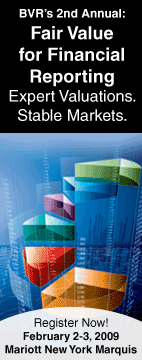
| BV community mourns the loss of James S. Rigby, Jr. (1946-2009) The BVWire™ extends its deepest condolences to the many friends and family of James “Jim” Rigby, Jr., CPA/ABV, ASA, who passed away last Friday. A memorial service will be held on Saturday, January 24, 2009 at 4:00 pm at First Presbyterian Church of Hollywood. All those who would like to attend are welcome. The family has requested that in lieu of flowers, donations be made to the “Jim Rigby Memorial Fund” at: Jim Rigby Memorial Fund The statement below—honoring Jim’s life and contributions to the BV profession—was issued by his friend and colleague Terry Allen, CPA/ABV, ASA: “It is with deep sadness that I inform you of the passing of Jim Rigby who has made invaluable contributions to our profession. He was an active member of the ASA, the AICPA, and IBA, as well as being a past member of the Valuation Advisory Committee of the ESOP Association and founding member and president of the Financial Consulting Group. Jim was also a frequent speaker at conferences and the author of a number of articles and books. “Within the ASA, Jim was best known as an instructor. At the recent joint ASA/AICPA Conference in Las Vegas, he was recognized with an award as Volunteer of the Year for his hard work as the conference chair and for his work with the BV committee’s strategic planning, marketing, website, and education efforts. Jim usually worked behind the scenes, but many initiatives (such as recent BV webinars) were the result of his creative thinking and persistence in overcoming obstacles. Education was one of his passions. In addition to being an instructor, he was a BV201 course developer, facilitated the development of BV301 Valuation of Intangible Assets for Financial Reporting Purposes, and served on the BV Education Subcommittee. “Jim was a member of the AICPA Examination Committee for the ABV Designation in 1998 when the designation was launched, and he was inducted in the AICPA Business Valuation Hall of Fame in 2000. He was also an editor of the CPA Expert and a member of the Goodwill Impairment Taskforce. “Although he was intensely interested in organizational issues and politics, Jim’s greatest passion was for helping and mentoring BV professionals, staff members, and other people he encountered—who became part of his vast extended family. The reason for his informal nickname of the “Pastor” in our company went far beyond the fact that his first degree was in the ministry. He was constantly seeking ways to assist others. He counseled those seeking advancement—finding them opportunities to serve in professional organizations. If you were out of work or looking for a new position, he would find a way to help you. If you were sick, dealing with an unruly child, or overwhelmed with the care of an elderly parent, he would support you with his sympathy and prayers.” Jim will be greatly missed. The recession’s effects on discounts for lack of marketability A recent issue of the Wire included the article, “Reduced liquidity may lead to larger marketability discounts in the current economy,” featuring a comment made by Lance Hall, ASA, of FMV Opinions in New York City at the 2008 Summit on Discounts for Lack of Marketability. Hall maintained that, “During periods of increased volatility, investors desire an increased ability to sell, so it makes sense that cash flows might decrease in an analysis, and discounts might also increase.” In a Letter to the Editor, Ronald M. Seaman, FASA, of Tampa, Florida’s Southland Business Group, responded that it would not be difficult to prove such a statement by studying the current costs of publicly traded LEAPS put options compared to costs in some earlier period. To find out, Seaman—while in the process of preparing an exhaustive study of 2008 discounts for lack of marketability based on LEAPS—decided to address the issue (see the table below). His conclusion: Lance Hall is exactly right. In fact, Seaman’s research found that “discounts for lack of marketability in late November 2008 are more than double those in August 2006, and, in virtually every case, the underlying stock prices per-share are much lower as well.” According to Seaman, “The 283 companies are all of the companies whose names begin with the letters A through F and who had LEAPS put options available for purchase on both study dates. As in my prior studies, the discount is calculated as the cost of the put option divided by the price of the stock.” He adds, “In the November 2008 study, company counts are significant for two reasons. First, despite the major increases in option costs (which resulted in higher discounts) and a three-month shorter option period, market makers in 2008 did not offer a two-year option (2011 option) for 103 companies that they sold options for in 2006 (the 2009 option); clearly this is a reflection of long-term risk in the market. Secondly, the difference between 283 companies in 2006 and 259 companies in 2008 (24 companies) is due almost exclusively to the fact that in 2008 the stock of these companies sold for well below the minimum option price of $2.50 per share, so no meaningful discount could be calculated. “It is also an interesting result of perceived market risk in 2008 that the absolute percentage spread (i.e., the cost of the option) between the one-year (the 14-month or 17-month option) and the two-year option (the 26-month or 29-month option) has increased from the 3% to 4% range in 2006 to the 7% to 8% range in 2008,” Seaman says. Seaman is currently conducting another study of the entire LEAPS market that will focus on industry differences. The results will not be ready for a few months; however, you can read the entire 2006 study online. IVSC exposure drafts aim to improve transparency of intangible valuations The International Valuation Standards Council (IVSC) has issued two exposure drafts on the valuation of intangible assets:
The drafts are a major revision of the IVSC’s earlier guidance, which dates to the late 1990s. The introduction of International Financial Reporting Standard (IFRS) 3 on Business Combinations in 2004 led to an increased demand for intangible asset valuation. In 2007, the IVSC issued a Discussion Paper Determination of Fair Value of Intangible Assets for IFRS Reporting Purposes, which attracted worldwide comment and interest and led to the development of the two exposure drafts. The International Valuation Standards Board, the independent standard setting body of the IVSC, has the responsibility for developing the drafts from exposure through to final guidance. “Intangible Asset valuation has grown into a truly international discipline over recent years, but is still little understood,” says Chris Thorne, Chairman of the Standards Board. “Raising the awareness and understanding of best practice should in turn lead to investors and others gaining greater confidence in the values attached to business assets such as brands or intellectual property.” One click access to SSVS No. 1 It has been a year since the Statement on Standards for Valuation Services No. 1 (SSVS No. 1) “Valuation of a Business, Business Ownership Interest, Security, or Intangible Asset” took effect for all AICPA members who perform an engagement that estimates the value of a business, business interest, security or intangible asset for numerous purposes, including sales transactions, financing, taxation, financial reporting, mergers and acquisitions, management and financial planning, and litigation. If you are one of the more than 25,000 CPAs who currently provide Business Valuation and Forensic & Litigation Services (BVFLS) or one of the more than 2,500 CPAs that hold the AICPA’s Accredited in Business Valuation (ABV) credential, it’s a good time to review the standard. To assist, the BVWire now offers immediate access to SSVS No. 1. Just go to Free Downloads page at BVResources.com. BVWire UpdateThanks to readers who noted an oversight in the headline of last week’s BVWire mention on SFAS 141R. Stamos Nicholas, of course, is a principal and national Business Valuation leader, with Deloitte Financial Advisory Services LLP and not PwC as was incorrectly cited in our title. FYI: You can catch more of Nicholas’ expert insights at our much-anticipated 2nd Annual Summit on Fair Value for Financial Reporting on February 2-3 in New York City. |
To ensure this email is delivered to your inbox,
please add editor@bvwire.com to your e-mail address book.
We respect your online time and privacy and pledge not to abuse this medium. To unsubscribe to BVWire™ reply to this e-mail with 'REMOVE BVWire' in the subject line or click here.
Copyright © 2009 by Business Valuation Resources, LLC
BVWire™ (ISSN 1933-9364) is published weekly by Business Valuation Resources, LLC
Editorial Staff | Advertise in the BVWire | Copyright Notice
|
|




